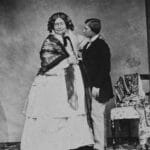A Roman Princess with a Captivating Past
History often feels like a distant world, but some stories reach through the ages to captivate our imaginations. Drusilla of Mauretania the Younger, born into Berber royalty on the fringe of the Roman Empire, is one such figure. Her story, interwoven with power, politics, and a possible link to Cleopatra, beckons us to uncover its secrets.
Born in Caesaria, Mauretania (modern-day Algeria), Drusilla was likely the daughter of King Ptolemy and possibly Queen Cleopatra Selene II. This is where the story takes a captivating turn. Cleopatra Selene II was probably the daughter of the legendary Cleopatra VII of Egypt and Mark Antony. If accurate, this lineage would make Drusilla the great-granddaughter of Cleopatra, a tantalizing connection to a period of epic love, war, and power struggles.
Tragically, Drusilla’s early life was disrupted when Emperor Caligula executed her father in 40 AD. Still young, Drusilla was swept away to Rome, thrust into the grandeur and intrigue of the Roman court.
Despite the upheaval, life in Rome offered Drusilla a prestigious Roman education, raised among the imperial family. This upbringing likely exposed her to the complexities of Roman politics and culture, shaping her into a significant figure within the empire’s power dynamics.
Marriages of Political Significance
Arranged marriages were the norm for high-ranking women, and Drusilla’s were no exception. Her unions reveal much about her importance in the Roman world:
Table: Drusilla of Mauretania’s Marriages
| Marriage | Husband | Date | Political Significance |
|---|---|---|---|
| First Marriage | Marcus Antonius Felix | c. 53 AD | Strengthened ties between Rome and Judea |
| Second Marriage | Sohaemus | c. 56 AD | Consolidated her royal status within the Roman Empire |
Her first marriage was to Marcus Antonius Felix, a powerful Roman official who served as the procurator of Judea. This alliance likely aimed to strengthen ties between Rome and its eastern provinces.
Drusilla later married Sohaemus, who held the intriguing title of priest-king of Emesa. This marriage further solidified Drusilla’s status within the Roman world.
A Life at the Crossroads of Cultures
As a Berber princess navigating the Roman court, Drusilla embodies the fascinating cultural exchange of the Roman Empire. She represents a living bridge between the Berber world of North Africa and the heart of Roman power. Drusilla’s very existence challenges us to consider the diversity of Roman society and the role women played in shaping its destiny.
While the historical record leaves much of Drusilla’s life shrouded in mystery, her story, pieced together from fragments, offers a glimpse into a world both familiar and strange. The ongoing debate among historians about her exact lineage, particularly her potential connection to Cleopatra, only adds to her mystique.
Drusilla of Mauretania’s story, though incomplete, reminds us that history comprises countless individual stories, each a thread in the rich tapestry of the past. Her life, poised between cultures and empires, encourages us to look beyond familiar narratives and seek out the hidden voices that deserve to be heard. What other secrets lie buried, waiting to be unearthed and shared with the world?
Unlocking the Legacy: Drusilla Urania, Princess of Mauretania
Delving deeper into Drusilla Urania’s life, we enter the tumultuous world of the 1st century AD, a time of significant upheaval and transformation in the Roman world. Imagine chariots rumbling over stone streets, the grandeur of towering temples, and the ever-present hum of political maneuvering – this was the world Drusilla inhabited.
Born into privilege in Caesarea, the capital of Mauretania (now Algeria), Drusilla’s lineage connected her to some of history’s most famous figures. Her claim to fame? Being the great-granddaughter of Cleopatra and Mark Antony, a heritage that likely had a profound impact on her life. Growing up with tales of these powerful figures likely provided her with a unique perspective and possibly influenced her interactions within the Roman imperial family.
From Mauretania to Rome: A Life Transformed
Scholars believe it highly probable that Drusilla was taken to Rome as a young girl, where she grew up amidst the opulence and machinations of the imperial court. This suggests an elite education and exposure to the inner workings of Roman power. We can envision her navigating the complex social circles of the empire’s elite, mastering the delicate dance of courtly life.
Around 53 AD, Emperor Claudius orchestrated Drusilla’s marriage to Marcus Antonius Felix, the Roman Procurator of Judea. In this significant position, Felix essentially governed the region on behalf of Rome, placing Drusilla at the heart of Roman administration in a turbulent province. However, this union was relatively short-lived, and the couple divorced in 56 AD.
Following her divorce from Felix, Drusilla married Sohaemus, the Priest-King of Emesa (located in modern-day Syria). This strategic marriage highlights the interconnectedness of the ancient world and suggests Drusilla’s continuing influence. Marrying a Priest-King would have been a politically astute move, placing her within a different, but equally powerful, sphere of influence.
A Life Shrouded in Mystery
While the exact circumstances of her death remain shrouded in mystery, we know she passed away around 79 AD. Some historians suggest the eruption of Mount Vesuvius, which devastated Pompeii and Herculaneum, might have played a role, although this is not definitively confirmed. More research is ongoing in this area, and perhaps future discoveries will shed more light on the final chapter of her life.
Key Aspects of Drusilla Urania’s Life:
| Aspect of Life | Details | Possible Interpretations/Significance |
|---|---|---|
| Ancestry | Great-granddaughter of Cleopatra and Mark Antony | Connection to powerful historical figures, potential influence on her upbringing and social standing |
| Upbringing | Likely raised in Rome within the imperial family | Access to elite education, exposure to Roman politics and culture |
| First Marriage | Marcus Antonius Felix, Roman Procurator of Judea (c. 53-56 AD) | Position of influence within Roman administration, involvement in the affairs of a turbulent province |
| Second Marriage | Sohaemus, Priest-King of Emesa | Connection to a different power structure, potential for religious and political influence |
| Death | c. 79 AD | Circumstances not fully known, ongoing research into potential connections with historical events like the eruption of Mount Vesuvius |
Drusilla Urania’s life provides a captivating glimpse into the complex world of the 1st century AD. She was more than just a princess; she was a woman navigating a world of power, politics, and cultural exchange. Her story, though fragmented, reminds us that even seemingly distant figures from history had lives filled with drama, ambition, and perhaps even moments of quiet contemplation. We may never know the full extent of her story, but what we do know paints a picture of a woman whose life intertwined with some of the most significant events and personalities of her era. Ongoing research may one day unveil more details about this remarkable woman who lived at the crossroads of empire and history.
When Was the Royal Mausoleum of Mauretania Built? Unraveling the History of a North African Wonder
The Royal Mausoleum of Mauretania, a monument to love and power, was constructed in 3 BC by King Juba II and his queen, Cleopatra Selene II. This powerful couple sought to showcase the connection between their families – the Numidians and the Ptolemies – through this architectural masterpiece.
While known locally as “Kubr-er-Rumia,” meaning “Tomb of the Christian Woman,” the mausoleum’s original name has been lost to time. Located in modern-day Algeria, its design reflects a beautiful fusion of architectural styles.
Sadly, despite its age and historical significance, the Royal Mausoleum faces challenges. Urban encroachment, neglect, and the passage of time threaten this incredible structure.
Dive into the captivating details of the political marriage between Henry III of Navarre and Marguerite of Valois, a union that would shape the course of French history. Henry III of Navarre marriage to Marguerite of Valois
- Discover White Fruits: Ultimate Guide to Taste & Nutrition - April 8, 2025
- Read Wonderful New World: Korean Manhwa Hit - April 8, 2025
- Discover Japanese Drawings: A Complete Guide - April 8, 2025

















1 thought on “Drusilla of Mauretania: The Untold Story of Cleopatra’s Great-Granddaughter and Roman Princess”
Comments are closed.